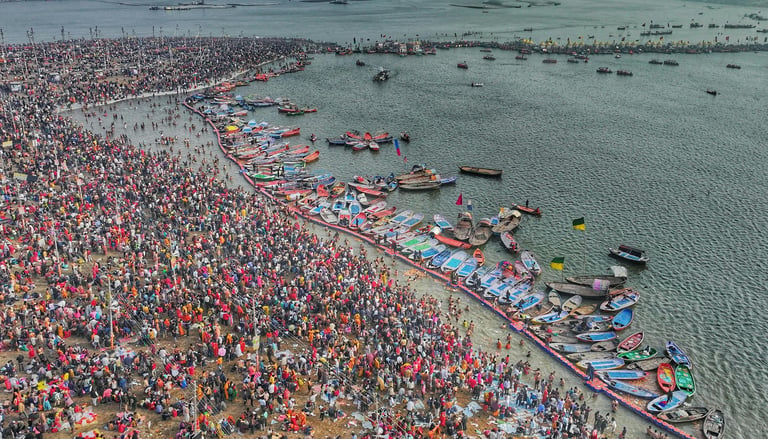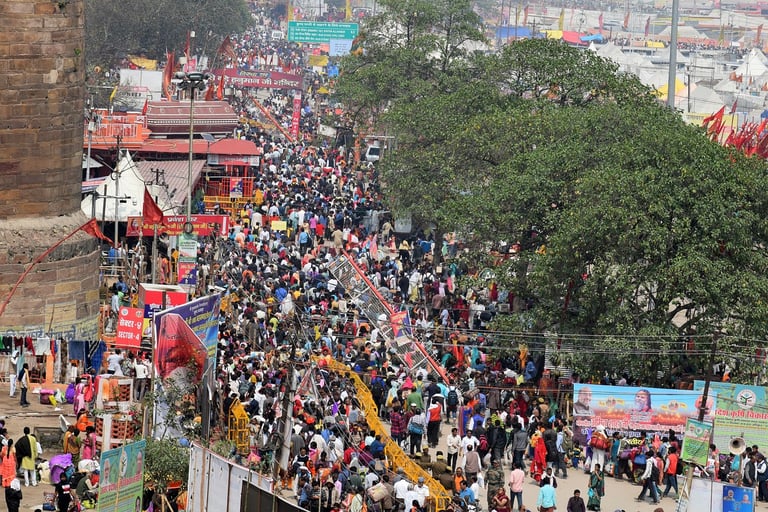Kumbha Mela: A Cosmic Convergence of Faith and Eternity
Experience the Kumbh Mela—where celestial legend meets earthly devotion, and millions gather in a sacred rhythm of faith. Unravel its journey from myth to history, a testament to the eternal quest for divine connection.
CULTUROSCOPE


Every twelve years, the sacred riverbanks of India come alive with devotion, as millions of pilgrims, sages, and seekers gather for one of the world’s largest spiritual gatherings: the Kumbha Mela. This grand event is not merely a festival, but a profound convergence of mythology, astronomy, and humanity’s timeless search for liberation. Steeped in ancient lore and cosmically timed alignments, the Kumbha Mela is an expression of the soul’s yearning for transcendence, where the temporal meets the eternal.
At the heart of this spiritual phenomenon is the belief in moksha—the liberation from the cycle of life and death. Pilgrims come to bathe in the holy waters of the sacred rivers, seeking cleansing of sins and a divine rebirth. But the festival's origins go far beyond rituals, tracing their roots to the ancient tale of Samudra Manthan, the Cosmic Churning.
The legend of Samudra Manthan, or the Churning of the Ocean, is the foundation of the Kumbha Mela's spiritual significance. According to Hindu mythology, the gods (Devas) and demons (Asuras) were locked in an eternal battle for supremacy. In their quest for immortality, they sought the Amrit, the nectar of eternal life, hidden in the depths of the Kshira Sagar (Ocean of Milk).
To obtain the Amrit, the gods and demons united their forces, using Mount Mandara as the churning rod and Vasuki, the king of serpents, as the rope. The gods held Vasuki’s tail, while the demons grasped his head, pulling with all their might.
As the churning began, a terrible poison, Halahala, emerged from the mouth of Vasuki, spewing out in response to the immense pain of the churning process. This poison threatened to destroy the world. In an act of boundless compassion, Lord Shiva consumed the deadly Halahala, turning his throat blue and earning the name Neelkantha, meaning "the blue-throated one."
From the churning of the ocean arose treasures like Kamadhenu (the wish-fulfilling cow), Lakshmi (the goddess of wealth), and the Kalpavriksha (the wish-fulfilling tree). But the ultimate prize was the Kumbha, the pitcher containing the nectar of immortality.
To protect the Amrit from the demons, Lord Vishnu, disguised as Mohini, deceived the Asuras and distributed the nectar to the Devas. In the process, four drops of Amrit fell to Earth, sanctifying the locations of the Kumbha Mela: Prayagraj in Uttar Pradesh (where the Ganga, Yamuna, and the mythical Saraswati rivers converge), Haridwar (on the banks of the Ganga) in Uttarakhand, Nashik (on the banks of the Godavari) in Maharashtra, and Ujjain (on the banks of the Shipra) in Madhya Pradesh.
These sacred sites, where the drops of Amrit touched the Earth, are now the focal points of this grand spiritual event.
The Kumbh Mela is held every twelve years, a rhythm intricately tied to the movement of the planet Jupiter, known as Brihaspati in Hindu astrology. Jupiter takes twelve years to complete its revolution through the twelve zodiac signs, aligning with the sacred locations of the Kumbh Mela during specific celestial configurations. In Hindu mythology, Brihaspati, revered as the guru of the devas, is regarded as a symbol of wisdom and divine guidance. His presence in this cycle signifies not only the cosmic order but also the spiritual essence of the Kumbh Mela, reinforcing its deep connection to celestial and mythological harmony.
In Hindu cosmology, the number twelve has profound significance, symbolizing the completion of a cosmic cycle, the Yuga cycle, that governs time in vast spans. The twelve years of the Kumbha Mela align with the ancient belief that this is the time it takes for the divine energy to complete a full cosmic journey. During this sacred time, the alignment of the planets and the flow of energy are at their peak, making the act of bathing in the holy waters not just symbolic, but transformative.
How is the site decided?
The alignments of Jupiter, Sun, and Moon during the Kumbh Mela determine not only when but also where the gathering occurs. Jupiter’s position, crucial in Vedic astrology for its association with wisdom and expansion, influences the timing of the festival with its 12-year orbital cycle. This makes the Purna Kumbh Mela a rare and auspicious event. Meanwhile, the positions of the Sun and Moon further enhance the sacredness of the confluence of the rivers, amplifying the spiritual significance of the gathering during specific months.
Haridwar: Jupiter in Aquarius (Kumbha), Sun in Aries (Mesha), and Moon in Sagittarius (Dhanu).
Prayagraj (Triveni Sangam): Jupiter in Taurus (Vrishabha) and Sun and Moon in Capricorn (Makara).
Nashik: Jupiter and the Sun in Leo (Simha).
Ujjain: Jupiter in Leo (Simha) and Sun in Aries (Mesha).
In addition to the Purna Kumbha Mela, the cycle includes the Ardh Kumbha Mela, held every six years at Prayagraj and Haridwar, symbolizing the midway point of Jupiter’s 12-year celestial journey. Complementing these grand gatherings is the Magh Mela, an annual spiritual observance at Prayagraj during the auspicious month of Magha (January-February). While smaller in scale, these events maintain the rhythm of devotion and continuity, connecting pilgrims to the profound cosmic and terrestrial harmony that defines the Kumbha tradition.
Apart from the regular Kumbh Mela, there is a rare and extraordinary event known as the Mahakumbh Mela, which occurs once every 144 years at Prayagraj. This special occurrence is distinguished by a unique alignment of the Sun, Moon, and Jupiter, amplifying the spiritual significance of the gathering. The Mahakumbh is regarded as the most auspicious of all, drawing even more devotees in search of spiritual awakening. The last Mahakumbh took place in 1881, and the next Mahakumbh is currently being hosted in 2025 at Prayagraj, Uttar Pradesh. This grand spiritual gathering, which began on January 13, 2025, will last until February 26, 2025, lasting for approximately 45 days.
Rituals and Traditions:
The Kumbha Mela is a vibrant confluence of rituals, prayers, and divine energy, creating an atmosphere of devotion that transcends time and space:
Shahi Snan (Royal Bath): The most sacred and significant ritual, in which the Naga Sadhus and ascetics from various Akharas take the first dip in the holy waters, marking the beginning of the festival’s spiritual purification.
Kalpavas: Pilgrims engage in intense periods of fasting, meditation, and prayer by the riverbanks, dedicating themselves to spiritual asceticism and devotion.
Yajnas and Katha: Sacred fire rituals and divine storytelling sessions elevate the spiritual consciousness, weaving the threads of faith and knowledge through the hearts of all who gather.
Ganga Aarti: Devotees gather to offer their prayers, light lamps, and sing hymns in honour of the sacred river.
These rituals are not just religious ceremonies, but a collective expression of humanity’s deepest spiritual aspirations. They bind individuals together, forming a community of seekers united in their quest for the divine.
While the Kumbha Mela is deeply rooted in mythology and spirituality, it also has notable psychological and physical effects. Modern studies have explored the benefits of large-scale collective meditation, which has been shown to lower stress and elevate the mood of participants. The convergence of millions of people creates a unique energy, a sense of oneness that fosters peace and healing.
The Kumbh Mela is not only a spiritual journey but also a remarkable cultural and logistical phenomenon. Recognized by UNESCO in 2017 as an Intangible Cultural Heritage of Humanity, it celebrates India’s rich traditions, uniting people from all walks of life in a shared moment of faith and unity. This recognition highlights the Mela’s profound spiritual significance and its pivotal role in India’s cultural heritage. Beyond its spiritual and cultural importance, the Kumbh Mela also showcases India’s logistical ingenuity, where temporary cities are built to accommodate millions of pilgrims. Modern technologies and crowd management techniques ensure the smooth flow of vast numbers, demonstrating how this ancient tradition continues to thrive in the modern age.
The Kumbh Mela calls us to witness the profound convergence of faith, culture, and human spirit, reminding us of the eternal quest for truth and unity. As millions gather on the sacred banks, we are invited not just to observe, but to connect deeply with this timeless tradition, which transcends generations and borders. Let us honour this incredible journey, embracing its wisdom and transformation, and carrying its essence forward in our own lives. May the lessons of devotion, humility, and harmony from the Mela resonate in our hearts, guiding us toward a more meaningful existence.
Subhalakshmi Buragohain
Hyderabad
Kumbh Mela: Where Time, Faith, and Eternity Converge.
Kumbh Mela: The World’s Largest Gathering of Soul and Spirit


